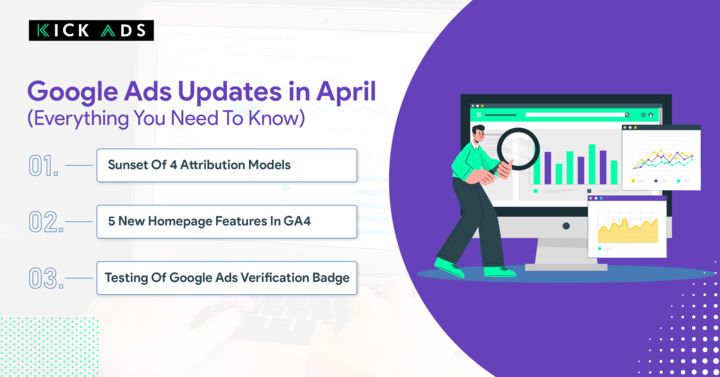Google has been always keeping users updated on their improvements and new features to make sure that advertisers can always have a better user experience in using Google Ads and can achieve better results in their ROI. In this latest April update, Google has announced the removal of 4 attribution models from Google Ads and Analytics and introduced 5 new Homepage features launched in GA4. Meanwhile, Google is also testing a new gold verification badge in Google Ads for advertisers.
Google Ads Update 1:
Sunset Of 4 Attribution Models
Google has announced that 4 attribution models will be deprecated later this year. The 4 rules-based attribution models that are going to be removed are:
- First-click
- Linear
- Time decay
- Position-based
Based on predefined rules, each advertising touchpoint will be assigned value by rules-based attribution models. While these models result in a lack of flexibility that is required to adapt to evolving consumer journeys. Due to low adoption rates in the rules-based attribution model, only lesser than 3% of Google Ads web conversions were attributed. To achieve a better result, Google has made a data-driven attribution by default model as it uses Google AI that combined with auto bidding to study the impact each touchpoint has on conversions. There were positive results when using the data-driven attribution model, it gained an uplift of 8.6% in conversions. This result was received by the retailer ASOS in the U.K.
When will rules-based and position-based attribution models be deprecated? According to Google, Google Ads will sunset these starting in June, the ability to select first click, linear, time decay and position-based attribution models will be removed for conversion actions in Google Ads. In September 2023, Google will switch all conversion actions to data-driven attribution models by default. On the other hand, Google also announced that advertisers can continue to use the last-click model if they do not want to switch to data-driven attribution models.
At this point, these rules-based models will be removed from reporting, including the Overview page and the Model comparison report within the Attribution tab.
Data-driven attribution model will be set as the default model
Google will set the data-driven attribution model by default in all the new Google Ads conversion actions. A data-driven attribution model is a specific model for each advertiser as it uses the conversion data of each advertiser to calculate the actual contribution of all the ad interactions along the path to gain conversion. It includes both clicks and video engagements in Search ads, Shopping ads, YouTube ads, Display ads and Discovery ads, all the interacted ads will be calculated. In the latest model, it helps to reach your business goals better by learning the interacted keywords, ads, ad groups and campaigns which have a higher probability of leading to conversion. This model gives more credit based on valuable ad interactions along the conversion path. Advertisers can choose the best attribution model that suits their business and optimize the bidding based on a specific account’s performance data without extra guesswork.
Google Ads Update 2:
5 New Homepage Features In GA4
Google has released five new GA4 homepage features .
New Welcome Tutorial
For new Google Analytics 4 users, Google Analytics includes a short tutorial on the Home page that provides fundamental concepts and settings to get you started with your new property.
New Banner Along The Top Of The Home Page
Google Ads will be showing a banner titled “Verify your Google Ads settings” on the top of the Home page for those editors and administrators who use Google Analytics data to advertise. This banner highlights the major key tasks you must accomplish to bid upon Google Analytics 4 data. When you finish all of the steps in Setup Assistant, the banner will disappear automatically.
Improvements To The Suggested For You Section
In this section, it is now offering users all those cards that are popular in all Analytics properties as well as cards that users return frequently to assist all the new GA4 users to get a better user experience.
Dismiss Suggestions, Insights, And Recommendations
If Analytics shows a card in the “Suggested for you” or “Insights & recommendations” section, and you find that does not applicable to you, do just click on the thumbs-down button to dismiss the card. Once the card has been removed from your homepage, you won’t see it again for the coming 30 days. There is also an important thing to take note of here if you do not submit the feedback form that appears after you click on the feedback button, the cards will remain in view for the rest of your session. However, the cards will automatically disappear after 30 days in the future sessions. Google Analytics can improve the homepage experience for you in the future, based on what you had feedback.
Open Setup Assistant From Anywhere
An action button has been added on every page of Google Analytics 4 properties. If you want to know the number of tasks you have marked as complete in Setup Assistant, you can simply hover over to the button and you can check on it. Analytics unleashes the Setup Assistant when you click on the button and allows you to continue your remaining activities in GA4.
For more insights and recommendations, you can still access the Insights Hub to review all the recommendation cards including those you dismissed.
Google Ads Update 3:
Testing Of Google Ads Verification Badge
Google has been doing testing on verification badges for the advertisers that shows in search results but was only in blue colour verification label. Recently in April, there was a new Google Ads gold verification badge that is likely being tested for advertisers. This was not an official announcement by Google, however, it was noticed by Anonymous, he had screenshot it and posted it on his Twitter.
The previous old verified badge was in a blue shield with a white check mark while as you can see in the above screenshot shared by a Twitter user, the latest testing badge is in a gold shield with a black checkmark in it. We can see that there is a difference between badges that could bring a new impact for advertisers. Some other people noticed this new gold badge too. Google seems to be doing a continuing experimental test on the gold badge as part of their verification program for advertisers. Google verification badges may help to increase the brand credibility of users when advertisers are advertising on the search platform. These badge icons may potentially get more attention and increase the trustworthiness of users and potential customers. We can look forward to that.







